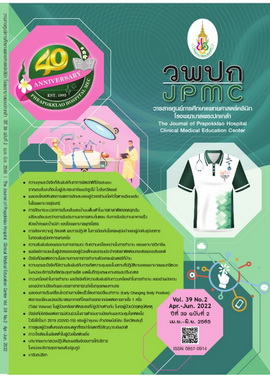Factors Associated with Physical Discomfort in Computer Users at Home
Main Article Content
Abstract
BACKGROUND: Computer usage can lead to physical discomfort. In Thailand, there are many studies about the risk of discomfort in workplaces but there is none in the user’s home setting.
OBJECTIVES: To investigate factors associated with physical discomfort in computer users in the home environment
METHODS: Cross-sectional study. A web-based survey of computer users aged 18-60 years who worked from home in a sitting position. The baseline characteristics, physical discomfort by online modified Thai Cornell Musculoskeletal Discomfort Questionnaires (CMDQ), and self-assessed posture by online modified Thai Rapid Office Strain Assessment (ROSA) were recorded. Factors affecting discomfort were analyzed by multiple logistic regression.
RESULTS: Almost all had discomfort (97.9%). Most had chronic discomfort (48.5%). Discomfort was commonly found at the neck (87.7%). There were 53% of participants in the severe group. The final ROSA score of five and greater was found at 63.2%. The highest ROSA score was in the chair section (4, median). BMI, high-stress level, and the final ROSA score of five and greater were associated with severe discomfort.
CONCLUSIONS: Severe chronic discomfort was commonly found. The most common area was the neck. Severe physical discomfort was associated with BMI, high-stress level, and the final ROSA score of five and greater. Correcting those modifiable factors should be encouraged.
Article Details

This work is licensed under a Creative Commons Attribution-NonCommercial-NoDerivatives 4.0 International License.
References
Shariat A, Cleland JA, Danaee M, Kargarfard M, Moradi V, Mohd Tamrin SB. Relationships between cornell musculoskeletal discomfort questionnaire and online rapid office strain assessment questionnaire. Iran J Public Health 2018;47:1756-62.
Poochada W, Chaiklieng S. Prevalence and discomfort characteristics of neck, shoulder and back pain among call center workers in Khon Kaen province. Srinagarind Med J 2015; 30:369-76.
Guerreiro MM, Serranheira F, Cruz EB, Sousa-Uva A. Self-reported variables as determinants of upper limb musculoskeletal symptoms in assembly line workers. Saf Health Work 2020; 11:491-9.
Kingkaew WM, Paileeklee S, Jaroenngarmsamer P. Validity and reliability of the Rapid Office Strain Assessment [ROSA] Thai Version. J Med Assoc Thai 2018:101:145-9.
Rittideah D, Polyong CP, Kongsombatsuk M. Factors predicting discomfort characteristics of neck, shoulder and back pain among employees in private office use computers in Rayong. Journal of the Department of Medical Services 2018;43(6):57-63.
Shah M, Desai R. Prevalence of neck pain and back pain in computer users working from home during COVID-19 pandemic: a web-based survey. Int J health Sci Res 2021;11(2):26-31.
Janwantanakul P, Sitthipornvorakul E, Paksaichol A. Risk factors for the onset of nonspecific low back pain in office workers: a systematic review of prospective cohort studies. J Manipulative Physiol Ther 2012;35:568-77.
Aegerter AM, Deforth M, Johnston V, Sjøgaard G, Volken T, Luomajoki H, et al. No evidence for an effect of working from home on neck pain and neck disability among Swiss office workers: Short-term impact of COVID-19. Eur Spine J 2021;30:1699-707.
Gerding T, Syck M, Daniel D, Naylor J, Kotowski SE, Gillespie GL, et al. An assessment of ergonomic issues in the home offices of university employees sent home due to the COVID-19 pandemic. Work 2021;68:981-92.
Ortego G, Villafañe JH, Doménech-García V, Berjano P, Bertozzi L, Herrero P. Is there a relationship between psychological stress or anxiety and chronic nonspecific neck-arm pain in adults? A systematic review and meta-analysis. J Psychosom Res 2016;90:70-81.
Fares J, Fares MY, Fares Y. Musculoskeletal neck pain in children and adolescents: risk factors and complications. Surg Neurol Int[Internet]. 2017[cited 2020 Mar 11];8:72. Available from: https://www.ncbi.nlm.nih.gov/pmc/articles/PMC5445652/
Myrtveit SM, Sivertsen B, Skogen JC, Frostholm L, Stormark KM, Hysing M. Adolescent neck and shoulder pain--the association with depression, physical activity, screen-based activities, and use of health care services. J Adolesc Health 2014;55:366-72.
Tantipanjaporn T, Yoonim Y, Tongmee Y, Keeratisiroj O. The effect of computer using workload on work-related upper extremity, neck and back musculoskeletal disorders among office workers. Srinagarind Med J 2019;34:60-7.
Walsh TP, Arnold JB, Evans AM, Yaxley A, Damarell RA, Shanahan EM. The association between body fat and musculoskeletal pain: a systematic review and meta-analysis. BMC Musculoskelet Disord [Internet]. 2018[cited 2021 Sep30];19(1):233. Available from: https://bmcmusculoskeletdisord.biomedcentral.com/articles/10.1186/s12891-018-2137-0
Seaman DR. Body mass index and musculoskeletal pain: is there a connection? Chiropr Man Therap [Internet]. 2013 [cited 2021 Sep 30];21(1):15. Available from: https://chiromt.biomedcentral.com/articles/10.1186/2045-709X-21-15
